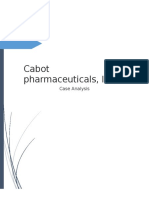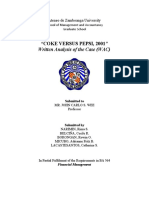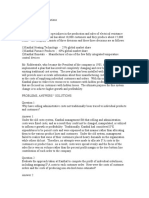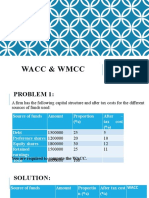Coke Vs Pepsi
Coke Vs Pepsi
Uploaded by
divakar62Copyright:
Available Formats
Coke Vs Pepsi
Coke Vs Pepsi
Uploaded by
divakar62Original Description:
Original Title
Copyright
Available Formats
Share this document
Did you find this document useful?
Is this content inappropriate?
Copyright:
Available Formats
Coke Vs Pepsi
Coke Vs Pepsi
Uploaded by
divakar62Copyright:
Available Formats
COKE VERSUS PEPSI CASE STUDY
Economic Value Added (EVA); Advantages and Disadvantages
The Economic Value Added (EVA) is a measure of surplus value created on an
investment. It is closest in both theory and construct to the net present value of a
project in capital budgeting. It is the difference between the firms after-tax
return on capital and its cost of capital.
The basic concept of EVA is that performance should be measured in terms of the
value added during the period. It is a measure of performance that is directly
linked to shareholder wealth.
Advantages of EVA
1. EVA is closely related to NPV. It is closest in spirit to corporate finance
theory that argues that the value of the firm will increase if you take
positive NPV projects.
2. It avoids the problems associated with approaches that focus on
percentage spreads - between ROE and Cost of Equity and ROC and Cost
of Capital. These approaches may lead firms with high ROE and ROC to
turn away good projects to avoid lowering their percentage spreads.
3. It makes top managers responsible for a measure that they have more
control over - the return on capital and the cost of capital are affected by
their decisions - rather than one that they feel they cannot control as well
- the market price per share.
4. It is influenced by all of the decisions that managers have to make within
a firm - the investment decisions and dividend decisions affect the return
on capital (the dividend decisions affect it indirectly through the cash
balance) and the financing decision affects the cost of capital.
Disadvantages of EVA
1. The calculation process requires numerous adjustments to profit and
capital employed figures.
2. EVA does not facilitate comparisons between divisions since EVA is an
absolute measure.
3. WACC calculation includes a huge number of assumptions.
4. EVA is based on historical data, which might not continue in the future.
Coca-Cola and Pepsi Co. EVA [1994-2000]
As shown in Exhibit 1, between the period 1994-2000, Coca-Cola has had a much
more stable EVA figure as compared to Pepsi Co. It should be noted though that
Coca-Colas EVA has been depreciating from 1997-2000. Pepsi Co., on the other
hand, has shown negative EVA figures in the past but has been increasing rapidly
and passed Coca-Colas EVA in 2000.
Such trends in EVAs can be explained somewhat by Roger Enricos (Pepsi CEO)
decision to sell off KFC, Taco Bell and Pizza Hut in 1997. Coca-Colas EVA figures
have been mainly driven by the recent difficulties faced due to the economic
environment but even more due to the business mistakes made by Doug Ivester,
CEO from 1997-1999.
To understand the key drivers of EVA, it is important to look at the formula for
EVA:
( )
Where, ROIC = Return on Invested Capital = NOPAT/ Invested Capital
Exhibit 1 shows that both Coca-Cola and Pepsi have a similar value of WACC and
between 1994-1998; Coca-Cola had lesser invested capital than Pepsi but had
higher ROICs and hence higher EVAs. For the year 2000, the situation reversed
and hence Pepsi Co. had a higher EVA. Thus, it can be concluded that for this case
the deciding factor for EVA analysis is the Return on Invested Capital (ROIC).
Weighted Average Cost of Capital (WACC)
WACC refers to the Weighted Average Cost of Capital, which is the average of the
costs of all sources of financing used by a firm. By calculating a weighted average,
we can see how much interest the company has to pay for every dollar it
finances. A firm's WACC is the overall required return on the firm as a whole. It is
considered the appropriate discount rate to use for cash flows with risk that is
similar to that of the overall firm. A firms WACC can be calculated using the
following formula:
WACC is a very significant number and is often used to assess the soundness of a
companys financial position. When considering a new project or a
merger/acquisition, WACC is used to discount the cash flows to understand the
NPV of the project and understanding the WACC of a target company gives an
idea of what level of returns are required to remain profitable in the future.
Hence, WACC is a vital input to decision making at a corporate level.
From the definition of WACC, it can be seen that WACC is dependent upon the
firms capital structure and the markets valuation of the firms riskiness,
reflected in the cost of capital sources provided the corporate tax rate is
constant. As we know, it is the managements decision to change the percentage
of debt to equity in the firm so; theoretically, the manager can reduce WACC by
changing the capital structure. In general, debt is cheaper than equity but at the
same time, increasing debt means higher riskiness and hence leads to higher
and
.
WACC Calculation
As mentioned above, following are the steps involved in the calculation of WACC
for a firm:
Cost of Debt (
):
As both Coca-Cola and Pepsi Co. have debt that is publicly traded, the most
appropriate method would be to calculate the yield to maturity on this debt,
which can be used as a measure for cost of debt. As shown in Appendix 1, Coca-
Cola has a before tax cost of debt of 7.09% whereas Pepsi Co. has a value of
6.92%. Assuming a tax rate of 35%, the after-tax cost of debt of Coca-Cola and
Pepsi Co. is 4.61% and 4.50% respectively.
Cost of Equity (
):
There are three main techniques that analysts use to calculate the Cost of Equity,
the Capital Asset Pricing Model (CAPM), the Dividend Discount Model (DDM) and
Equity Capital Model. CAPM is considered the most appropriate model as it
incorporates the firms beta, the risk-free rate and the market risk premium.
Hence using CAPM,
)
Using data from Exhibit 8, the current yield of 5.73% on 10-year U.S. Treasuries
is taken as the risk-free rate,
. The average beta () for both Coca-Cola and
Pepsi Co. is given as 0.88. The geometric mean of the Equity risk premium of
5.90% is taken as the market risk premium because geometric mean includes
compounding. As shown in Appendix 1, using the above values, the cost of equity
of Coca-Cola and Pepsi Co. is 10.92%.
Market Value of Debt (D):
The market value of debt can be calculated by using data given in Exhibit 6 (for
Coca Cola) and Exhibit 7 (for Pepsi) that are the total long-term debt, the par
value of the coupon and the current price of the debt traded. As shown in
Appendix 1, the Market Value of Debt for Coca-Cola and Pepsi Co. is
$623,387,400 and $1,964,055,600 respectively.
Market Value of Equity (E):
The market value of equity can be calculated by multiplying the current share
price as on December 4, 2000 with the total number of outstanding shares as
given in Exhibit 8. We use the number of diluted shares to account for
convertible securities, preferred stocks, warranties, etc. As shown in Appendix 1,
the market value of equity for Coca-Cola and Pepsi Co. was found to be
$156,059,250,000 and $64,619,750,000 respectively.
WACC:
Substituting all of the above mentioned value in the WACC formula,
It is found that Coca-Cola has a WACC of 10.90% whereas Pepsi Co. has a WACC
of 10.73%, provided the data is accurate. Interestingly, even though Pepsi Co. has
a much higher amount of long-term debt, their cost of debt offsets the WACC and
Coca-Colas higher market value of equity leads to higher WACC for Coca-Cola
than Pepsi.
EVA Calculation [2001-2003]
As mentioned above, the first step in calculating the Economic Value Added
(EVA) is to calculate the firm WACC that has already been done previously. The
next step is calculating the Invested Capital.
Using the data provided in the balance sheet in Exhibit 6(for Coca-Cola) and
Exhibit 7(for Pepsi), the Invested Capital can be calculated by subtracting A/P
and accrued liabilities from the Total Assets. The accumulated Goodwill
Amortization has been excluded from this calculation due to the lack of
information for the years 2001-2003. As shown in Appendix 2, Pepsi Co has a
consistently higher Invested Capital as compared to Coca-Cola.
The next step in estimating EVA is to calculate the firms Net Operating Profit
after Taxes (NOPAT). Using the data from Exhibit 6 & 7, NOPAT can be calculated
by subtracting the income taxes paid from the Operating Income. Appendix 2
shows that in terms of NOPAT, Coca-Cola consistently outperforms Pepsi Co.
The next step is to calculate the Return on Invested Capital (ROIC) by dividing
the NOPAT by the Invested Capital. Appendix 2 shows that as expected, Coca-
Cola consistently outperforms Pepsi Co. in terms of ROIC.
Now, using ( ) , the Economic Value
Added (EVA) for both companies can be calculated for the coming three years,
2001-2003.
EVA Interpretation & Conclusion
Appendix 2 shows that assuming the forecast data is accurate, the Economic
Value Added (EVA) by Coca-Cola is consistently higher than Pepsi Co. Once again,
it can be seen that Coca-Colas ROIC is higher than Pepsi Co.s which further
strengthens the argument that ROIC is the key driver of EVA.
The above graph clearly shows that based on EVA, Coca-Cola will significantly
outperform Pepsi Co. between the years 2001-2003 and hence, Coca-Cola should
be chosen as the firm which would create most value.
$-
$500,000,000.00
$1,000,000,000.00
$1,500,000,000.00
$2,000,000,000.00
$2,500,000,000.00
$3,000,000,000.00
2001 2002 2003
E
V
A
Coke vs Pepsi EVA Forecast[2001-2003]
Pepsi Co.
Coca-Cola
To have a more robust view of the situation, it is important to look at the EVA
figures for both companies from 1994-2003 together. It is also important to note
that in the long run, Coca-Cola can survive more efficiently since it has faced near
bankruptcy cases and recovered from them whereas Pepsi Co. has not.
In conclusion, based on the EVA analysis, Coca-Cola would be considered the
clear favourite for the future. It should also be noted that Coca-Cola and Pepsi
Co.s recent attempts to enter other market segments is likely to be highly
profitable given the changes in customer orientations from carbonated drinks to
non-carbonated drinks.
$(1,500,000,000.00)
$(1,000,000,000.00)
$(500,000,000.00)
$-
$500,000,000.00
$1,000,000,000.00
$1,500,000,000.00
$2,000,000,000.00
$2,500,000,000.00
$3,000,000,000.00
1
9
9
4
1
9
9
5
1
9
9
6
1
9
9
7
1
9
9
8
1
9
9
9
2
0
0
0
2
0
0
1
2
0
0
2
2
0
0
3
E
V
A
Coke vs Pepsi EVA [1994-2003]
Pepsi Co.
Coca-Cola
APPENDIX 1
WACC Calculations
Cost of Debt
Coca-Cola Pepsi Co.
Face Value $1,000.00 $1,000.00
Annual Coupon Rate 5.75% 5.75%
Number of Payments 17 15
Coupon Payments per year 2 2
Current Bond Price $915.40 $932.60
Yield to Maturity/ Kd before tax 7.09% 6.92%
Corporate Tax Rate 35% 35%
After Tax Cost of Debt 4.61% 4.50%
Cost of Equity
Coca-Cola Pepsi Co.
Risk-free Rate 5.73% 5.73%
Beta 0.88 0.88
Market Risk Premium 5.90% 5.90%
Cost of Equity/ Ke 10.92% 10.92%
Market Value of Debt
Coca-Cola Pepsi Co.
Long-term Debt $681,000,000.00 $2,106,000,000.00
Par value of Coupon $1,000.00 $1,000.00
Current price of traded debt $915.40 $932.60
Market Value of Debt $623,387,400.00 $1,964,055,600.00
Market Value of Equity
Coca-Cola Pepsi Co.
Current Share Price $62.75 $43.81
No. of outstanding shares 2,487,000,000.00 1,475,000,000.00
Market Value of Equity
$156,059,250,000.00
$64,619,750,000.00
Wd or [D/(D+E)] 0.40% 2.95%
We or [E/(D+E)] 99.60% 97.05%
WACC 10.90% 10.73%
APPENDIX 2
EVA Calculations
2001
Coca-Cola Pepsi Co.
Total Assets
$21,434,000,000.00
$22,757,000,000.00
A/P and accrued liabilities $3,796,000,000.00 $5,017,000,000.00
Invested Capital
$17,638,000,000.00
$17,740,000,000.00
Operating Income $5,399,000,000.00 $4,385,000,000.00
Income Tax $1,682,000,000.00 $1,406,000,000.00
Accumulated Goodwill Amortization $- $-
NOPAT $3,717,000,000.00 $2,979,000,000.00
ROIC 21.07% 16.79%
WACC 10.90% 10.73%
EVA $1,795,008,180.08 $1,075,053,066.64
2002
Coca-Cola Pepsi Co.
Total Assets
$21,901,000,000.00 $25,716,000,000.00
A/P and accrued liabilities $3,868,000,000.00 $5,284,000,000.00
Invested Capital
$18,033,000,000.00 $20,432,000,000.00
Operating Income $6,132,000,000.00 $4,885,000,000.00
Income Tax $1,894,000,000.00 $1,593,000,000.00
Accumulated Goodwill Amortization $- $-
NOPAT $4,238,000,000.00 $3,292,000,000.00
ROIC 23.50% 16.11%
WACC 10.90% 10.73%
EVA $2,272,965,501.27 $1,099,133,949.13
2003
Coca-Cola Pepsi Co.
Total Assets
$22,311,000,000.00
$25,511,000,000.00
A/P and accrued liabilities $4,066,000,000.00 $5,573,000,000.00
Invested Capital
$18,245,000,000.00
$19,938,000,000.00
Operating Income $6,633,000,000.00 $5,369,000,000.00
Income Tax $2,062,000,000.00 $1,783,000,000.00
Accumulated Goodwill Amortization $- $-
NOPAT $4,571,000,000.00 $3,586,000,000.00
ROIC 25.05% 17.99%
WACC 10.90% 10.73%
EVA $2,582,864,114.16 $1,446,152,539.04
You might also like
- LiquidityDocument9 pagesLiquiditynewalbertblkyan100% (3)
- Case Study: "Buildair: To The Sky and Beyond" - Preparation WorkDocument3 pagesCase Study: "Buildair: To The Sky and Beyond" - Preparation WorkSameed Khan100% (1)
- Operations ManagementDocument10 pagesOperations ManagementAK JRNo ratings yet
- Case Study The Morrison CompanyDocument4 pagesCase Study The Morrison CompanyAbhishek Prasad RoyNo ratings yet
- Cartwright Lumber CompanyDocument6 pagesCartwright Lumber Companykiki0% (2)
- Porter Five Forces Analysis Steel IndustryDocument8 pagesPorter Five Forces Analysis Steel Industrydivakar62100% (3)
- Hill Country Snack Foods Case AnalysisDocument5 pagesHill Country Snack Foods Case Analysisdivakar62No ratings yet
- Group3 Jim TeagueDocument5 pagesGroup3 Jim TeagueAbhinavNo ratings yet
- Delta Beverage Case With HedgingDocument7 pagesDelta Beverage Case With HedgingMorsalNo ratings yet
- The Treadway Tire Company Case StudyDocument2 pagesThe Treadway Tire Company Case StudySandip DarjiNo ratings yet
- Group 12 - Automation Consulting ServicesDocument1 pageGroup 12 - Automation Consulting ServicesRISHABH GUPTANo ratings yet
- Lecture Notes Lectures 1 9 Advanced Financial AccountingDocument22 pagesLecture Notes Lectures 1 9 Advanced Financial Accountingsir sahb100% (1)
- J Boats CaseDocument4 pagesJ Boats CaseAnel01No ratings yet
- Loewe: Commitment To Lean Management?Document8 pagesLoewe: Commitment To Lean Management?Hamza MoshrifNo ratings yet
- Evaluacion Preliminar Due Diligence Negociacion: Bally CapitalDocument2 pagesEvaluacion Preliminar Due Diligence Negociacion: Bally CapitalRoberto DistintoNo ratings yet
- AF 325 Pioneer PetroleumDocument6 pagesAF 325 Pioneer PetroleumHiepXickNo ratings yet
- Final PrimoDocument5 pagesFinal Primoaissel50% (2)
- Cabot Pharma. Case ReportDocument3 pagesCabot Pharma. Case ReportdrdeathNo ratings yet
- Shouldice Hospital Case StudyDocument9 pagesShouldice Hospital Case StudyEmily McCannNo ratings yet
- SybilaDocument2 pagesSybilaragastrmaNo ratings yet
- Daniel Dobbins Case AnalysisDocument6 pagesDaniel Dobbins Case AnalysisAnuvinder Chauhan67% (3)
- JP MORGAN - David FernandezDocument32 pagesJP MORGAN - David FernandezAsian Development BankNo ratings yet
- Hernandez Cristina - Student Activity Packet Investing UnitDocument23 pagesHernandez Cristina - Student Activity Packet Investing Unitapi-51266945050% (2)
- UNI 20161102144415836098 270758 uniROC PrepaidDocument8 pagesUNI 20161102144415836098 270758 uniROC PrepaiddanteNo ratings yet
- SecuritizationDocument102 pagesSecuritizationag maniac100% (18)
- Coke Vs Pepsi, 2001Document5 pagesCoke Vs Pepsi, 2001Bibhu Prasad BiswalNo ratings yet
- CASE 14 Coke Vs PepsiDocument15 pagesCASE 14 Coke Vs PepsiAlyaYusofNo ratings yet
- Case Study Coca Cola Vs PepsiDocument13 pagesCase Study Coca Cola Vs PepsiAlyaYusof50% (2)
- Case: Tofee Inc. Demand Planning For Chocolate Bars: Assignment - 2Document2 pagesCase: Tofee Inc. Demand Planning For Chocolate Bars: Assignment - 2Nitin ShankarNo ratings yet
- Cartwright Lumber Company Paper EXAMPLEDocument5 pagesCartwright Lumber Company Paper EXAMPLEJose SermenoNo ratings yet
- When Salaries Are Not SecretDocument2 pagesWhen Salaries Are Not Secretgollasrinivas100% (1)
- Treadway Tire Company Implementation Plan: and Must Increase Their Change of PaceDocument10 pagesTreadway Tire Company Implementation Plan: and Must Increase Their Change of PacerenaldooNo ratings yet
- BenDocument5 pagesBenSaad JavedNo ratings yet
- RMC Case PDFDocument1 pageRMC Case PDFAnaghNo ratings yet
- Harley Davidson Case StudyDocument8 pagesHarley Davidson Case StudyfossacecaNo ratings yet
- TreadWay Tire CompanyDocument8 pagesTreadWay Tire CompanyGopi ModhNo ratings yet
- PolarSports Solution PDFDocument8 pagesPolarSports Solution PDFaotorres99No ratings yet
- Destin Brass Products Co Case WorksheetDocument2 pagesDestin Brass Products Co Case WorksheetManishNo ratings yet
- Belmont Industries Case StudyDocument8 pagesBelmont Industries Case StudySaptarshi MaitraNo ratings yet
- Cabot Pharmaceutical IncDocument6 pagesCabot Pharmaceutical IncJorge Mora Ramos100% (1)
- Exec 04Document1 pageExec 04Mohsin JalilNo ratings yet
- Stryker Corporation XLS ENGDocument5 pagesStryker Corporation XLS ENGNhung Nguyễn Hồng0% (1)
- Exhibit 1Document2 pagesExhibit 1Natasha PerryNo ratings yet
- Fuel SalesDocument11 pagesFuel SalesFabiola SE100% (1)
- Helena HelsenDocument2 pagesHelena HelsenragastrmaNo ratings yet
- Case Analysis - Toy WorldDocument11 pagesCase Analysis - Toy Worldvarjin71% (7)
- Sherman Motor Compant Case Analysis Sherman Motor Compant Case AnalysisDocument5 pagesSherman Motor Compant Case Analysis Sherman Motor Compant Case AnalysisChristian CabariqueNo ratings yet
- Motives and Motivation - Tony RoderickDocument2 pagesMotives and Motivation - Tony RoderickGlory100% (1)
- Solved Morrison Company Uses A Job Order Costing System To Assign ManufacturingDocument1 pageSolved Morrison Company Uses A Job Order Costing System To Assign ManufacturingDoreenNo ratings yet
- AcsDocument2 pagesAcsArief Hidayatullah KhamainyNo ratings yet
- Allied Stationary Products (A) OpgaveDocument5 pagesAllied Stationary Products (A) OpgaveKonesanSubasNo ratings yet
- Surecut Shears, Inc.: AssetsDocument8 pagesSurecut Shears, Inc.: Assetsshravan76No ratings yet
- Star Bucks Case AnalysisDocument19 pagesStar Bucks Case Analysisarchanasingh22No ratings yet
- Polar Sports: Where Does Polar Sports Fit in The Course?Document21 pagesPolar Sports: Where Does Polar Sports Fit in The Course?Hugo100% (1)
- Hausser Food ProductsDocument4 pagesHausser Food ProductsHumphrey Osaigbe100% (2)
- Toffee Inc PDFDocument4 pagesToffee Inc PDFDaniel BarrientosNo ratings yet
- Case 5Document15 pagesCase 5Qiao LengNo ratings yet
- "Coke Versus Pepsi, 2001" Written Analysis of The Case (WAC)Document10 pages"Coke Versus Pepsi, 2001" Written Analysis of The Case (WAC)CAO Basilan State CollegeNo ratings yet
- Case StudyDocument5 pagesCase StudynanthamkNo ratings yet
- Kanthal CaseDocument5 pagesKanthal CaseMonica Rosa LinaNo ratings yet
- SafeBlend Fracturing ReportDocument3 pagesSafeBlend Fracturing Reportsjois.hsNo ratings yet
- Forner Carpet CompanyDocument4 pagesForner Carpet CompanyTanya SinghNo ratings yet
- Carrefour S.A.: Ruskin Lisa Crystal WeiDocument16 pagesCarrefour S.A.: Ruskin Lisa Crystal WeiThái Hoàng NguyênNo ratings yet
- Letter From PrisonDocument10 pagesLetter From PrisonNur Sakinah MustafaNo ratings yet
- Questions - Linear Technologies CaseDocument1 pageQuestions - Linear Technologies CaseNathan Toledano100% (1)
- By by Kelly Kelly Natch Natch Louis Louis Sven Sven Spring 2012 Spring 2012 Financial Administration Financial AdministrationDocument9 pagesBy by Kelly Kelly Natch Natch Louis Louis Sven Sven Spring 2012 Spring 2012 Financial Administration Financial Administrationhhjj111220% (1)
- Olympia Machine Company Inc - 11 - BDocument7 pagesOlympia Machine Company Inc - 11 - BAbhijit PandaNo ratings yet
- Capm AnalysisDocument18 pagesCapm Analysisnadun sanjeewaNo ratings yet
- Dominos CaseDocument25 pagesDominos Casedivakar62100% (1)
- Porsche Volkswagen Case StudyDocument3 pagesPorsche Volkswagen Case Studydivakar62No ratings yet
- Jet Blue IPO CaseDocument4 pagesJet Blue IPO Casedivakar6250% (2)
- Caltex Vs CA (Digest)Document2 pagesCaltex Vs CA (Digest)Glorious El Domine100% (1)
- Problem 4: Auditing and Assurance Concepts and ApplicationDocument7 pagesProblem 4: Auditing and Assurance Concepts and ApplicationJasmineNo ratings yet
- Chart of Accounts For Government AccountingDocument10 pagesChart of Accounts For Government AccountingNeil ArmstrongNo ratings yet
- Divergence System by Oleg A. ButDocument0 pagesDivergence System by Oleg A. ButGeorge Akrivos100% (2)
- My Complete Project B.com HONSDocument37 pagesMy Complete Project B.com HONSnitishmittal199067% (3)
- Trading Power Trends With ADX by DRDocument6 pagesTrading Power Trends With ADX by DRpaoloNo ratings yet
- Wallet Behavioral Finance PDFDocument15 pagesWallet Behavioral Finance PDFAli100% (1)
- FIN625 SovedMCQsLesson145Document48 pagesFIN625 SovedMCQsLesson145adeelali849714No ratings yet
- Final Practice Questions and SolutionsDocument12 pagesFinal Practice Questions and Solutionsshaikhnazneen100No ratings yet
- Securities and Exchange Commission (SEC) - Form11-KDocument2 pagesSecurities and Exchange Commission (SEC) - Form11-Khighfinance100% (1)
- WMCC Assignment 15TH AprilDocument18 pagesWMCC Assignment 15TH AprilRamya GowdaNo ratings yet
- TB 17Document40 pagesTB 17Hasan100% (2)
- York Capital's Letter To InvestorsDocument7 pagesYork Capital's Letter To InvestorsDealBook100% (12)
- Fed Funds Futures Probability Tree CalculatorDocument4 pagesFed Funds Futures Probability Tree CalculatorAlok Singh100% (1)
- DBD StrategyDocument5 pagesDBD StrategyJoão BarbosaNo ratings yet
- John Keells Holdings: Key HighlightsDocument14 pagesJohn Keells Holdings: Key HighlightsSupunDNo ratings yet
- Low Latency Library For HFT-Algo-Logic-4831a009Document8 pagesLow Latency Library For HFT-Algo-Logic-4831a009Bo FerrisNo ratings yet
- Larsen & ToubroDocument15 pagesLarsen & ToubroAngel BrokingNo ratings yet
- Strategy Implementation: Chapter NineDocument36 pagesStrategy Implementation: Chapter NineÇağla KutluNo ratings yet
- Riding Yield CurveDocument30 pagesRiding Yield CurveThant ZinNo ratings yet
- Pakiaral Ang Report Guys TNXDocument13 pagesPakiaral Ang Report Guys TNXJophet Banabana MagalonaNo ratings yet
- SIPM Appointment and Remuneration PolicyDocument3 pagesSIPM Appointment and Remuneration PolicyMohammad SyafiiNo ratings yet
- Par Value SharesDocument2 pagesPar Value SharesHyviBaculiSaynoNo ratings yet
- Accounting Final Notes 3120Document29 pagesAccounting Final Notes 3120Dhruv DarjiNo ratings yet






























































































